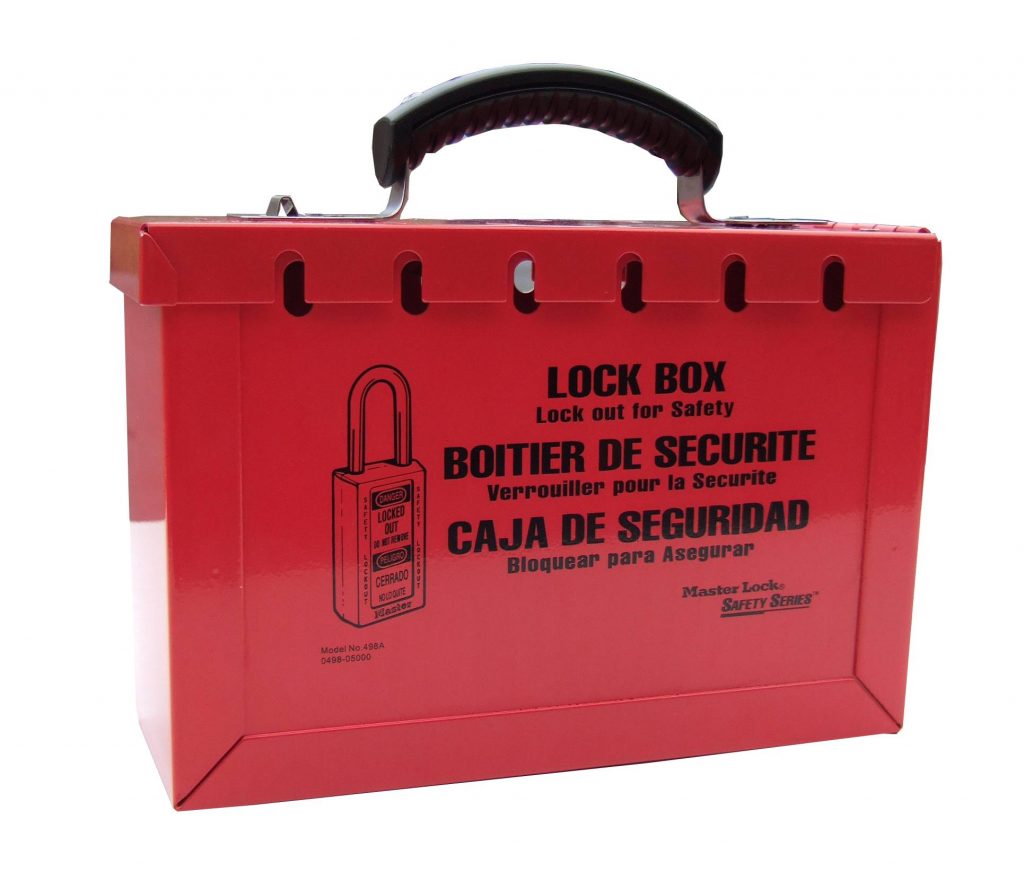The Regulation respecting occupational health and safety (RSST) contains a specific subsection on padlocking and other methods of controlling energy. The employer with authority over the establishment will be responsible for the application of energy control methods.
It is an energy control method that also includes energy control devices such as a lockout box.
The installation of padlocks ensures that all energy sources are maintained in a safe state throughout the work. A lockout box is one of the methods used to control energy sources when several workers must work on the same machine. This type of box is often used to implement a method of keeping a machine out of service, such as restarting it, closing an electrical circuit, opening a valve, releasing stored energy or moving apart of gravity, so that this state cannot be changed without the voluntary action of all persons with access to the danger zone.
STANDARD LOCKOUT PROCEDURE WITH OR WITHOUT A LOCKOUT BOX
Before starting maintenance or cleaning work on a machine, the power supply mode(s) of the machine must be identified.
Warn users that work will be carried out on the machine.
Before turning off the power, check with the person in charge that you can do so or ask him/her to turn off the power.
Attach your personal lock to the machine’s power source.
Keep the key in his possession (never leave it lying around or give it to another person).
Defuse, if necessary, the residual energy stored in the machine, i.e.: compressed air, spring, hydraulic energy, force of gravity, etc.
Close, drain and isolate the supply lines for hazardous materials.
Make sure that the power supply is actually switched off by operating the starting mechanism.
If the machine is dismantled for maintenance purposes, reassemble parts including all guards.
Make sure that no one can be injured when the machine is re-energized.
If this has to be done, inform users.
Remove the padlock.
Re-energize the machine if this is part of your job, otherwise recommend padlocking to make the necessary corrections.
It is possible that the machine may have already been stopped and padlocked before you arrive on the site. However, before starting work, the worker must:
Check to see if the power source is turned off;
Affix his personal padlock to the source.
If you must leave before the work is completed, you must notify the person in charge before removing your padlock. It is the responsibility of each worker to affix his personal padlock to the power source. At the end of the work, remove his padlock on the power source.
WHAT PADLOCKING IS NOT.
The use of a pin, cable tie, Ty wrap, tags, rope, tapes or other similar means to keep an isolation device from a power source locked is a method of padlocking unacceptable energy. This method is ineffective and therefore less safe, since it does not provide the user with sole control of the locking device by allowing anyone to return the machine or attachment to another state. Padlocks must be sufficiently robust.
Unfortunately, we tend to think only of electrical energy, but there are many other sources of energy:
– mechanical
– pneumatic;
– hydraulics
– thermal
– chemical
-gravitational
– Etc
An energy control method is a means of ensuring that all sources of energy are eliminated or reduced to a safe level for workers who will be performing an activity in the danger zone of a machine, even before the work is started.
The message conveyed by this procedure clearly indicates that the isolation or energy control device must not be activated as long as it is locked out.
SUMMARY ANALYSIS OF A CASE
Following the stoppage of the conveyor of the raw material feed line, Jean-François is called in to investigate the disturbance.
Individual padlocking Jean, and electromechanical is mandated to change a fan motor in a furnace. In order to do so, he is assisted by a subcontractor. According to the padlocking procedure, Jean shut down the furnace, opened the disconnect switch contacts, placed a hasp on the isolation device and installed his single-key padlock on the hasp. The subcontractor in turn installs a single key padlock on the hasp in place. The padlock is provided by the employer responsible for the establishment and is identified in the padlock register with the subcontractor’s name. John then performs a conclusive start-up test in the presence of the subcontractor. Both workers are now ready to change the engine. This situation depicts individual padlocking, which is defined as the locking of a single isolation device by one or more workers. The number of single-key padlocks used is equal to the number of workers involved.
Group Padlocking
A multidisciplinary team is mandated to change a paper machine. This work includes isolating the following sources of energy: steam, electricity, hot water and pneumatics. The team is composed of seven workers.
One of these workers is designated and trained to apply the energy control procedure and isolate all energy sources. To do so, this designated person consults the procedure and obtains a set of five equipment locks and a lockout box. He or she asks the machine operator to stop the machine. The operator isolates the energy sources by placing an equipment lock on each of the four isolation devices provided to control the paper machine’s energy sources. He then proceeds with the removal and control of residual energy. As required by the procedure, a start-up test is performed.
When the test is successful, the excess equipment padlock is placed in the lockout box along with the key to open the equipment padlocks. He installs his single-key padlock on the padlocking box and asks his colleagues to install their single-key padlocks in the same location. Since this work will take all week, the foreman comes in and affixes a control padlock on the lockout box. In this way, he is able to control the restarting of the new machine. Once all these steps have been completed, the workers are ready to proceed with the paper machine changeover.
The foreman must put the conveyor back into service as soon as possible, but Jean-Marc’s padlock is still installed on the lock box, preventing access to the key to the equipment padlocks and their removal from the isolation devices. The foreman must therefore apply the procedure to describe the steps to follow when a padlock is forgotten. He tries to contact Jean-Marc to have him come and remove his padlock from the lockout box. Unfortunately, despite several phone calls, the foreman cannot reach Jean-Marc. The foreman, with the help of one of the workers who had replaced the conveyor, inspected the machine’s danger zone to make sure that the work was being done properly, that there were no other workers in the area and that it would be safe to return it to service. Following these checks, the lock is removed.
Lockout procedures and padlocking devices are critical to the health and safety of workers during maintenance operations. It is now possible to lock out practically everything, electrical panels, ball valves, electrical cords, circular valves and others.
Here is a summary of the product groups offered;
– Xenex lock single key padlock (CA1X)

– Cable lockout device (CA1C)

– Electrical plug lock (CA5)

– Circuit breaker lock (CAC4, CAC5)

– Padlocking assembly ( CAE3 and CAE4)

– Group box for keys (CAEB)

– Lock for round valves (CAV)

– Miscellaneous lockout labels (CAET1, CAET2, CAET3 and CAET4)

Don’t wait for an accident to happen to you, it might be you! Act now by purchasing one of our lockout products. Consult Sylprotec or contact their customer service department.
Sylvain Patrice f.p.t
By the same author:
Allow us to introduce you to the general principles of the locking procedure (padlocking).
Convex mirror presentation 100 degrees, M64.
Combined emergency showers in industrial environments.
Presentation of the eyewash model PD19224PDC.
Sylprotec’s kit no. 4 is an easy choice.
Regulation respecting minimum standards of first aid and first aid.
1 Reproduction authorized with mention of the source © Commission des normes, de l’équité, de la santé et de la sécurité du travail, 2016 Legal deposit.
